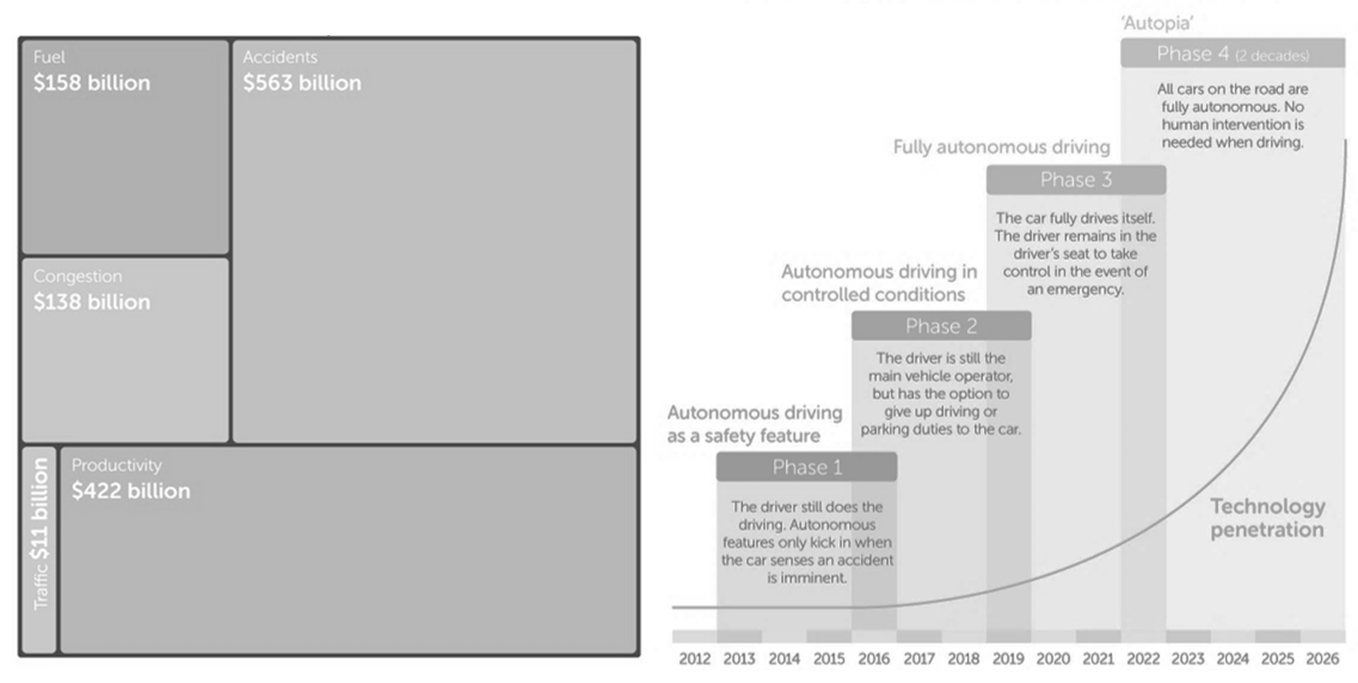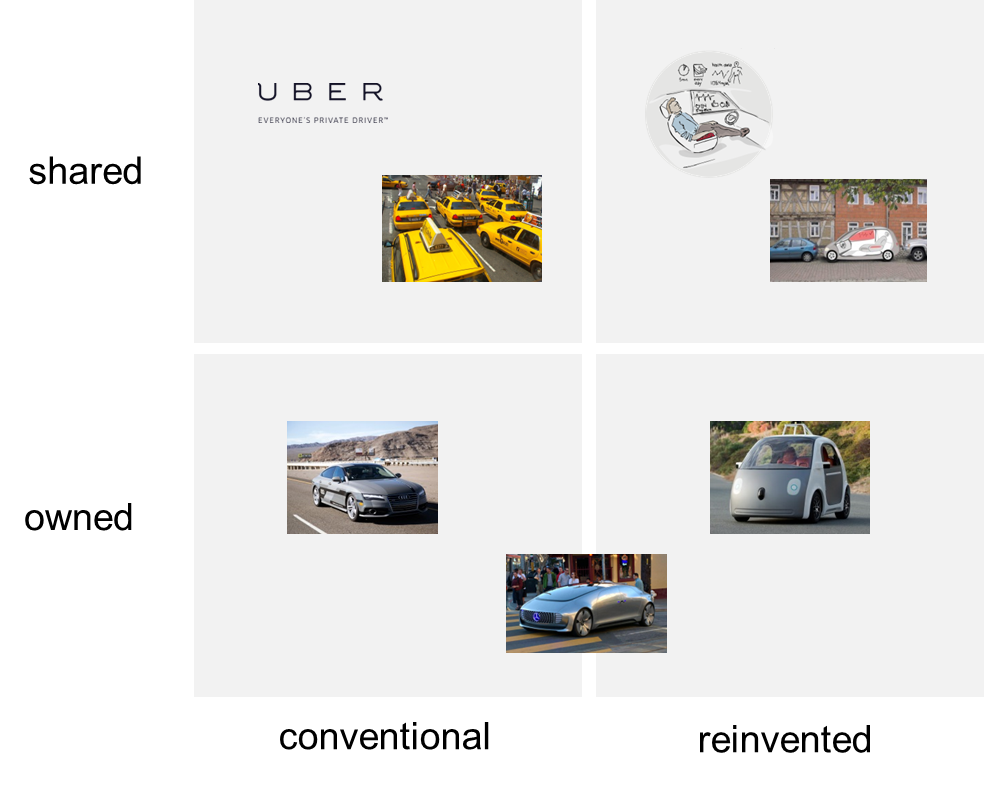1. The Innovation Path to Autonomous Driving
Our childhood dreams from the televisions series of Knight Rider are coming true. The Knight Industries Two Thousand (KITT) was a self-driving Pontiac Firebird Trans Am packed with lots of artificial intelligence supporting David Hasselhoff as Michael Knight and his public justice organization, the Foundation for Law and Government to fight down numerous villains. In the 80s the self-driving KITT was a science-fiction scenario for the audience. Today integrated camera, radar, laser, infrared and ultrasonic technology make it possible to record and interpret all relevant data from the car’s surroundings. Then, a control unit backed with lots of computing power can take over and drive the car without any human intervention. The autonomous car is definitely not a gadget for a few enthusiasts, it will be the most impactful and disruptive innovation in the history of the automobile with enormous social and economic implications. Moreover it is exciting that we are right now experiencing the birth of this innovation that will be around for the next centuries.
First estimations state that autonomous cars can contribute $1.3 trillion in annual savings to the US economy alone, with global savings estimated at over $5.6 trillion (Morgan Stanley 2013). There are many drivers for the overall savings as illustrated in figure 1. For example improvements in fuel consumption can be achieved when driving smoothly or using cruise control compared to manual breaking and throttling. Moreover, self-driving cars could prevent 90 percent of road traffic accidents which are mainly caused by human error. Over 40 percent of fatal crashes involve alcohol, distraction, drug involvement and/or fatigue. When you take into account the loss of earnings, household production, medical and emergency services costs, travel delay and administration costs this adds up to a huge amount of money. There are huge productivity gains as occupants do not have to drive anymore and can use the new free time. Better traffic management on roads with connected and autonomous cars will lead to less congestion. These saving predictions will however only apply in a world of fully autonomous cars. This is phase 4 of Morgan Stanley’s forecast of technology penetration shown in figure 2.

Figure 1a: $1.3 Trillion US Annual Savings according to Morgan Stanley. Figure 1b: Adoption Timeline of Autonomous Driving. Source: infographic by NeoMam Studios http://www.businessinsider.com/morgan-stanley-autonomous-cars-trillion-dollars-2014-9?IR=T
Next to some analysts’ estimations of the expected economic impact I want to add an additional perspective on the innovation path of autonomous driving using the Gartner’s Hype Cycle combined with the Roger’s Diffusion Model of Innovation. The Hype Cycle offers a suitable tool to evaluate the current stage and relative maturity of the technology in the early phases of their life cycle (Fenn 2010). The Model can be used to indicate consumer attitudes towards technology (Linden & Fenn 2003) and can serve as a basis to analyse opportunities and investment risks regarding a certain technology (Linden & Fenn 2003). The shape of the Hype Cycle curve in figure 2 illustrates the media overenthusiasm through the period of disillusion to an eventual understanding of the technology’s relevance and role in the market (De Marez Lieven & Gino 2004). Autonomous driving is positioned right now at the first ascending slope known as technology trigger. It is noteworthy that there is a huge gap between technological progress and end consumer acceptance what makes self-driving cars a showcase for a technology push innovation. Scientific research is focusing on the topic from engineering and ICT Perspective with most peer reviewed publications driven by the Institute of Electrical and Electronics Engineers (IEEE). Research on the user perspective and acceptance indicators are very rare and constitute an exciting research gap for the near future (Rosenzweig 2015). Social media content on the other side is increasing steadily especially since the year 2013.

Figure 2: The Innovation Path of Autonomous Driving
The Future of Autonomous Driving can be mentioned as one example of a curated blog collecting media content throughout the last years (Bartl 2013). The increasing content indicates the transition to the enthusiasm phase with a peak of inflated expectations which will be followed by a trough of disillusionment. In this stage we will experience that the maturity of autonomous driving in the user domain is rather low. On the one hand this is due to the missing of reasonable use case scenarios, and to the other hand due to the lack of triability (e.g. test drives) of the new technology. Both factors represent mandatory requirements for customers’ willingness to accept self-driving cars. Furthermore, according to Roger Diffusion of Innovation (2003) the relative advantage over existing solutions, the compatibility with existing values, the relative complexity and the observability will determine the pace of user acceptance and the course of the traditional adoption curve starting with the innovators and early adopters. A decisive point in figure 2 will be the entering stage of the diffusion curve. This is a familiar exercise for the auto manufacturers when it comes to the introduction of a new car model. However in this case self-driving cars cannot be treated simply as a new series. The innovation is too disruptive in all dimensions to do so. It has rather to be treated as the next wave of technology and a new S-Curve, companies need to jump on. Right now it seems that many automobile OEMs are thinking to overcome the entering stage of the diffusion model by simply continuing current car model strategies and at the same time scaling up advanced driver assistance systems until a full autonomous version. This intended seamless transition to autonomous driving may be attractive to preserve existing business models however won’t be adequate for the degree of disruptiveness self-driving cars offer for new business opportunities.
2. Adding the Demand Perspective to Autonomous Driving
The field of automotive innovation is so radical because it is embedded in a whole ecosystem where traditional players and non-traditional players are involved. Some known players in the game are OEMs, suppliers, logistics, passenger and freight transportation etc. Next to the advantage of fewer accidents one mayor outcome of autonomous driving will be that the occupant will have a substantial and increasing free time budget within the car. The fight to get a share of the consumer’s time budget already began. Just as a thought experiment make up your mind what known brands could do to serve their customers in the setting of fully autonomous cars. Warner Brothers, Barnes & Nobel, EA Games and the publishing houses want to bring their entertainment offerings and offered content in the car to reach a new audience. Companies like Goolge and Apple already working on their own autonomous cars to bring their services into the automobile. Car rentals or companies such as Uber see new opportunities for passenger transportation. Insurances develop new offerings. Designer and manufacturer of furnishing could think of new concepts to revolutionize the interior of cars. Why not realize a concept such as “Vitra inside” similar to the already familiar “Bose Soundsystem inside”. McDonalds Restaurants or Food Delivery services such as amazon fresh could utilize autonomous distribution services. The same with logistics companies such as DHL, Fedex or UPS. The energy providers such as Chevron, RWE and others could think of movable charging stations with can load, store and releases energy as part of a revolutionary decentralized energy system. Steel and carbon companies can think of totally new coachwork concepts. Nestlé and Unilever can invent new healthy snacking concepts for the occurring break time. Travel Agents such as Thomas Cook or TUI will have a huge playground to offer amazing experience routes and sceneries while you are in the car or travelling arrangements where you are driven over night to the holiday destinations of your choice. A provider of office accommodation such as Regus which is active in more than 100 countries can develop fleets of mobile offices to add them to its mortar and brick office offerings. When you think of this little though experiment and the hypothetical scenarios derived it becomes obvious that autonomous driving cannot be mastered by single industry. There will be new partnerships, collective efforts, business models, joint developments and ventures to profit from the new time budgets consumers can spend for competing activities such as working, relaxing, travelling, being entertained, eating etc. This is the reason why I want to call autonomous driving as the master class of open innovation. You need to utilize a collective brain and collective problem solving to handle all the new dimension of the demand side. Right now it really seems to be a field predominantly driven by technology push. Strongly missing is the consumer perspective as well as thoughts on use case scenarios and business model generation.
3. The Foresight Matrix on Autonomous Driving to Support Strategic Planning
In order to generate and evaluate strategic options for autonomous driving I want to introduce a 2×2 foresight matrix illustrated in figure 3. One major question concerns the ownership of a car or vehicle. Will it be privately owned or shared. Models of car sharing are on the rise and will gain even more importance as the degree of capacity utilization can be improved. Simply spoken, it makes no sense that on person uses an owned vehicle only two hours a day when the same car can move and offer it to other drivers in the remaining 22 hours. Thinkable are new private rental models such as it is already the case in accommodations with e.g. airbnb.

Figure 3: Strategic Planning and Foresight Matrix on Autonomous Driving
Another aspect of a shared model is that autonomous vehicles such as the mentioned office vehicles or autonomous food trucks may lead to many revolutionary ideas for new car fleet businesses. A prerequisite for this will be the ability to think of vehicle designs which are very different from anything known so far and I am sure that we will experience a new area of vehicle designs within the next 20 to 30 years. The transition of conventional design and reinvented design will be directly connected to the degree of autonomy. While semi-autonomous cars will rather be introduced to the market with more conventional designs, fully autonomous cars will offer new design playgrounds for the carbody, configuration and power units.
Technological innovation often moves faster than legal or regulatory systems. This is also the case in autonomous driving. In the long run legislative power will alter the existing status quo and follow the amazing technological progress with some general conditions. This was always the case with inventions and developments which changed the world. A statement of the National Highway Transportation Safety Administration (NHTSA 2013) In the short run on a business economics level the pace of the legislative regulation will definitely influence strategic and tactical decisions of companies in the autonomous driving game.
Would you like to download this article?
References
Bartl (since 2003): The Future of Autonomous Driving, http://www.scoop.it/autonomousdriving.
De Marez Lieven, S. B. & Gino, V. (2004). ICT-innovations today: making traditional diffusion patterns obsolete, and preliminary insights of increased importance. Telematics and Informatics, 21 (3), 235-260.
Fenn, J. & Raskino, M. (2008). Mastering the Hype Cycle: how to choose the right
innovation at the right time. Boston: Harvard Business Press.
Fenn, J. (2010). Hype Cycle for emerging technologies. Gartner Research, Retrieved,
7 (24), 2012.
Linden, A. & Fenn, J. (2003). Understanding Gartner’s hype cycles. Strategic Analysis Report No R-20-1971. Stamford: Gartner Inc.
Morgan Stanley Blue Paper: Autonomous Cars. Self-Driving the New Auto Industry Paradigm; November 2013.
National Highway Transportation Safety Administration (NHTSA 2013):
http://www.nhtsa.gov/About+NHTSA/Press+Releases/U.S.+Department+of+Transportation+Releases+Policy+on+Automated+Vehicle+Development; published May 30 2013.
Rogers, Everett (2003). Diffusion of Innovation, 5th Edition. Simon and Schuster. ISBN 978-0-7432-5823-4.
Rosenzweig, Juan (2015). A Study on Customer Perception of Autonomous Driving. forthcoming 2015.

